KAWAII
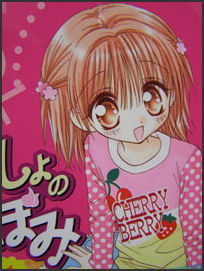
“Kawaii” (“cute”) has been an obsession in Japan since the 1960s. Young girls into this look in an extreme sense wear fake fur short coats, have angel wings attached to their backs, have little teddy bears dangling from cell phones and adore anything associated with Mickey Mouse and Pooh-san (Winnie the Pooh). There is an entire magazine called “Cutie” devoted to the “kawaii” look.
Kawaii manifests itself in Japanese anime on television, on road signs with warm and fuzzy bunnies and racoons, and in a seemingly nationwide infatuation with Mickey Mouse and Disney. And its not just a girl and kid thing. Salarymen decorate their cubicles with pictures of teenage idol singers. Shinto shrines sell Hello Kitty key chains. Even the black Mercedes of yakuza gangster have things like a row stuffed Poohs on the dashboard. Some say the Japanese obsession with kawaii began with a Japanese fascination for Petty Boop and really took off with idoloziaion of the American figure skater Janet Lynn.
One reader wrote into the Daily Yomiuri: “To be called cute is a high complement. Cute is cute because its looks harmless but on a deeper level is subordinate. Japan’s love for cute things has been internalized by women and demonstrated in their looks and actions. Because of this, life for women is full of day-to-day and lifelong compromises...Is cute all women are expected to be in Japan? More importantly, is that all they want to be? “Uru-kyara” means “cute, relaxed and unsophisticated.”
The Japanese Foreign Ministry chose model Misako Aoki, singer Yu Kimura and actress Shizuja to be “Kawaii taishi” (“Cute ambassadors”) to promote Japanese pop and kawaai culture abroad. In promotional appearances Aoki is dressed like a Lolita and Fujioka is clad in schoolgirl uniform.
See Manga
Characters and Mascots in Japan
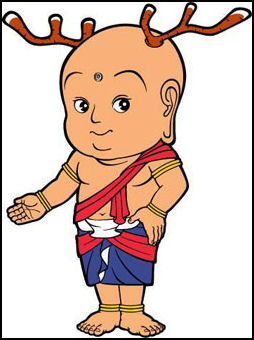
Nara mascot There are lots of mascots and characters in Japan. They are not only found in amusement parks and sports but are used to promote entire towns and new events When Japan decided to begin using a jury-based criminal system a parakeet was used a mascot to kick off a campaign to publicize, with Japan’s Justice Minister Kunio Hatoyama donning a parakeet suit to launch the campaign. The parakeets name is Saiban-inko (with “Saiban-in” meaning lay judges: and “inko” meaning parrot).
Mascots are widely used by local jurisdictions to bring attention and tourism to their areas. Known as “yuru-kyara”, meaning cute but unsophisticated, they often are linked to a festival, food speciality or animal associated with the region. Local governments like mascots because they “have a relatively low cost” and “their promotional effect is high.”
There are so many local mascots that competitions between them are held. The Yura-Kyara Cup in Tottori Sand Dunes in November in 2008, drew 52 yuru-kyara, competing in a steeplechase event and other events, and drew 6,800 spectators.
Some of the mascots are quite ridiculous. A mascot used t promote the 1,300th anniversary of the city of Nara was a childlike Buddha with antlers laying sideways in a swimsuit pose (Nara is famous for its large Buddha statue and its deer). The mascot was widely mocked. The negative publicity was estimated to have given Nara $15 million free publicity based on the amount the city would have had to pay if the free television exposure they got was paid commercial time. .
Some trace the Japanese fascination with cartoon mascots back to yokai traditional supernatural being that sometimes represented abstract ideas and sometimes took the form of everyday objects such as lanterns and umbrellas.
Book: “Hello Please” by Matt Alt and Horoko Yoda (Chronicle Books, 2008) is a pocket size photographic album with more than 2000 cartoon mascot characters divided into five categories: 1) official characters such as the police mascot Pipo-kun; 2) instructional characters such mustached Fuyu-shogun on NHK weather reports; 3) warning characters such as the chubby Statue of Liberty on a sign in Aomori Prefecture, urging citizens to “report suspicious foreigners”: 4) advertising characters such as the Yodobashi Camera anthropomorphic train and 5) food characters such as the wavy-haired wakane seaweed maiden.
In October 2010, voting was held to chose Japan’s No. 1 mascot. More than 170 characters for 33 prefectures entered with Tabo-kun — modeled after singer Takanori Nishikawaand representing Shiga Prefecture — the early favorite.
Sometimes there are mascot gatherings and festivals that feature mascot running rcaes and other events.
One business that seemed to be benefitting from the “yuru-kyara” mascot craze is Funny Craft a company in Konosu, Saitama that specialized in making full-body costumes. The firm fills ordered for costumes of famous manga characters as well as designs people dream up in their heads and scratch on a piece of paper. The firm boasts “a lively look, exactly the same as imagined,” The president of Konosu told the Yomiuri Shimbun, “Our fully-body suits fit you so well. They aren’t “loose” at all.”
Japan also has its share of popular plastic mascots which are generally used to promote some product or company. In addition to internationally-recognized favorites such as Colonel Sanders and Ronald McDonald, you can also find Peko-chan, the bobble headed, pigtails girl mascot for Fujiya confectioners; Satako-chan, the little pink elephant mascot for Sato Pharmaceutical Co., and her big brother Sato-can.”
Japan’s No. 1 Mascots in 2011: Kumamon, Bary-san, and Nishiko-kun
The 2011 National Yuru-chara Summit in Saitama Prefecture featured over 300 regional mascot characters and attracted about 135,000 people came to see them. The winner (based on the results of an online poll) was Kumamon (287,315 votes), a bear who represents Kumamoto prefecture: The runner-up was Bary-san (245,238 votes), a chicken representing the city of Imabari (Ehime). Third place went to Nishiko-kun (174, 079 votes), the bizarre mascot of Nishikokubunji (Tokyo). [Source: Japan Probe, November 2011]
Japan Probe reported: The real surprise was the Nishiko-kun. Until very recently, he was completely unknown, but enthusiastic support from netizens propelled him into the national spotlight: On November 15th, Nishiko-kun was in 84th place in the poll. After receiving attention from sites such as 2channel, he suddenly received tens of thousands of votes and jumped up to first place on November 20th. Apparently some people may have set up automated voting tools, so thousands of the votes were thrown out, sending Nishiko-kun back down to 10th place. Despite this setback, he able to get many more votes and finished in third place.
Yuru-Kyara Mascot Fever
Ryuzo Suzuki wrote in the Yomiuri Shimbun, “On a 350-meter shopping street in Hikone the crowd was so thick that people could hardly move. About 88,000 people gathered for the two-day event, according to the organizer. Were they here to taste a local specialty? Hoping to catch a glimpse of a TV personality? No, they were looking for "yuru-kyara" mascots. [Source: Ryuzo Suzuki, Yomiuri Shimbun, November 2012]
Yuru-kyara is an abbreviation of a phrase meaning "floppy characters." According to the Japan Local Character Association, there are about 1,000 mascots created by local governments and other organizations nationwide, from Hokkaido to Okinawa Prefecture. Such mascots personify local symbols, specialty products, animals and historical heroes to promote the regions they are from. Created often on limited budgets, the mascots look cute, soft and cuddly.
Hikone is the hometown of Hiko-nyan, a white cat dressed in ancient warrior gear who triggered the yuru-kyara boom. The town has hosted an annual yuru-kyara festival since 2008. This year, 244 mascots from 38 prefectures and overseas gathered for the fifth festival, and the number of participants hit a record high. A woman from Tsukuba, Ibaraki Prefecture, said: "I have chased after yuru-kyara mascots nationwide. The greatest appeal is their cuteness.”
Such mascots have joined road relay races or futsal games, and communicate with fans via blogs, Twitter or Facebook. Apparently, one reason for many fans being attracted to the mascots is that they easily get to know each mascot's charm via these social networks.
In Hanyu, Saitama Prefecture, the third Yuru-kyara Summit, where about 260 mascots will gather, is scheduled to be held in late November. The city plans to announce the result of a popularity poll on more than 800 mascots, which has been hotly contested on the Internet, and hopes that more than 150,000 people will come to the event. Shozo Kitamura, head of the Hikone Chamber of Commerce and Industry, said: "Whenever yuru-kyara mascots appear at events, the number of visitors shoots up. [The mascots] have become an important pillar for local economies.”
Local Mascots with Gotochi
Makoto Fukuda wrote in the Yomiuri Shimbun, “Mascots are appearing around the country as a way to promote local municipalities. Some take the form of local specialties, while others appear as anthropomorphic critters such as dogs and cats. Recently, the trend has swung toward cute "moe" female characters that can be featured in anime and video games to boost an area's "gotochi," or local area. The word gotochi adds a sense of respect and distinction to a region. [Source: Makoto Fukuda, Yomiuri Shimbun, September 21, 2012]
In September 2011, 2, these adorable moe characters gathered in Utsunomiya. Tochigi Prefecture to participate in the third gotochi moe character festival. The event first took place in Gunma Prefecture in June 2011, and was followed by a second festival in Sano, Tochigi Prefecture, in March.
Booths from 19 organizations were featured at the event and sold original character goods. Among them were the Ashikaga Himetama, female attendant-like characters inspired by real shrines where people go to pray for ties and separations in Ashikaga, Tochigi Prefecture. Transformation moe character Komine Shiro from Shirakawa, Fukushima Prefecture, as well as characters from Ryohoji temple in Hachioji, western Tokyo, known as the "moe temple," also participated in the festival.
Meanwhile, so-called gotochi idols such as Tochiotome 25 from Tochigi Prefecture and CoCoRo Gakuen from Gunma Prefecture performed live with anime voice actors and musicians on stage. On the same day, Haji festival was held at Washinomiya Shrine in Saitama Prefecture, which has become famous as a mecca for fans of the anime RakiSuta (Lucky Star). I asked the Ashikaga Himetama staff if they felt a sense of rivalry with RakiSuta. "RakiSuta is already famous. We have to advertise our characters at the grassroots level and hopefully, that will make them popular enough to be adapted into anime," said one of the Ashikaga staff.
Kawaii Characters
Takamasa Sakurai wrote in the Daily Yomiuri: "Kawaii" is translated as "cute" in English, "mignon" in French and "ke-ai" in Chinese. These words don't convey the same nuance. That's why the term kawaii has spread unchanged across the world. Kawaii is often used among girls overseas when referring to designs, characters and other things they love. When they describe an item as kawaii, they subconsciously imply that it is "Japanese." That's why people overseas say their favorite anime characters are kawaii.
Sanrio characters such as Hello Kitty and Cinnamoroll really embody this concept. There are character goods produced outside of Japan, so why are Japanese characters so kawaii” "The colors are different. I've liked Sanrio goods such as Hello Kitty and Kiki and Lala since I was a child," Sayumi Michishige of pop idol group Morning Musume said. "The colors featured with these characters, such as pastel pink, are recognizable and also project a girlish air. Pastel hues are used for Cinnamon and the design is simple. I just can't help loving it."
One of the appeals of Japanese characters is a sense of emotional attachment. The ability of Japanese creators to produce comforting characters is definitely an invaluable strength for Japan. Coloring is also another distinctive feature. The way pastel colors are made and used with these characters is unique to Japan.
Cinnamoroll is puppy characters created by Sanrio Co., the company which developed and popularized Hello Kitty. "It's just so cute. Cinnamon sitting beside me is comforting," said Michishige. Sanrio designer and Cinnamoroll creator Miyuki Okumura said: "I came up with a character design that is familiar-looking, but had never actually been created. It also has a cuddly air designed to fall into the arms of its fans. "As Michishige said, I made Cinnamoroll look simple so those who see it for the first time can feel a sense of familiarity and security. And that's how Cinnamoroll was created."
Hello Kitty
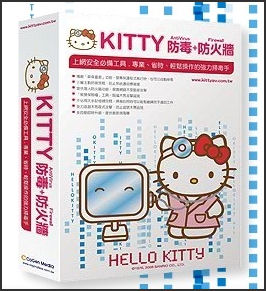
Hello Kitty
anti-virus firewall Hello Kitty is a kawaii-cute cat image owned by the company Sanrio and featured on a large array of merchandise. Described as "itsy-bitsy, kind and pretty," it was initially designed to appeal to children but turned out to be immensely popular with young women in their 20s and 30s and others. Hello Kitty images have popped everywhere from yakuza-style Mercedes to New York fashion shows. Britney Spears, Paris Hilton. Tori Spelling , Mariah Carey, Sarah Jessica Parker, Christina Aguilera and Cameron Diaz are among the top American stars seen with Hello Kitty merchandise.
The Hello Kitty image is relatively simple: just the outline of head, two dots for eyes, a little button nose, six whiskers and a ribbon or flower next to one ear. She doesn't have a mouth. Explaining one reason why, a Sanrio spokesman told Reuter, "Without the mouth, it is easier for the person looking at Hello Kitty to project their feeling on the character. The person can be happy or sad together with Hello Kitty."
Hello Kitty is not Japanese. According to Sanrio she was born in suburban London in 1974, weighs the same as three apples and loves “small, cute things.” In 2001, the official Hello Kitty fan magazine announced that Hello Kitty has a last name—“White.”
Hello Kitty accounts for about 80 percent of Sanrio’s overseas licensing revenues and 60 percent in Japan. Interest in Hello Kitty shot up after Sarah Jessica Parker and Christine Aguilera were photographed with bags and accessories featuring the little cat.
Book: “Hello Kitty: The Remarkable Story of Sanrio and the Billion Dollar Feline Phenomenon” by Ken Belson and Brian Bremmer (John Wiley & Sons, 2003).
Website: Sanrio website.
History of Hello Kitty
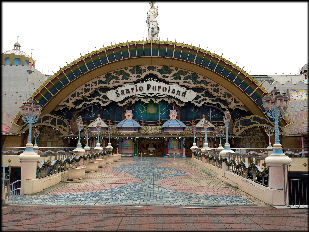
Puroland, home of Hello Kitty First marketed in 1974, Hello Kitty was the creation of Shintaro Tsuji, a Japanese businessman who, remembering his lonely orphanage childhood, wanted to create a character that could be viewed as a companion and friend.
Describing the early market research that led to Hello Kitty, he told the International Herald Tribune, "Dogs actually came in No. 1. Next came cats, white cats. Then it was bears. Then giraffes, lions and various wild animals." He decided there was no future in dogs because the market was already saturated with Snoopy. He flashed pictures other animals before his young son's school classmates who showed no interest in any of them. He then selected the cat.
Sanrio at that time was a one person company — Tsuji. He hired a cartoon artist to draw a cat. Then there was some discussion about what to call it. After selecting the English word "Kitty" Tsuji said he wanted something else the expressed his company's belief in "social communication." First he tried "Hi Kitty" but didn't like it. He then settled on the name that would make him a very rich man.
Five years after she was introduced people had grown sick of her and she nearly disappeared. Her rebirth in the 1980s was credited to a softening of her features by Sanrio designer Yuko Yamaguchi and putting her image on more products and orienting many of these products towards teens,
Hello Kitty Booms
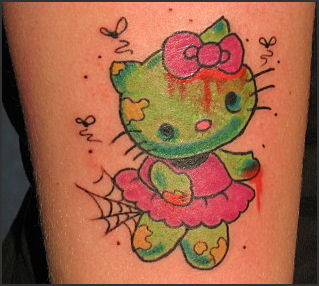
Hello Kitty tattoo Hello Kitty went through three major booms: first in the mid 1970s after it was introduced, mainly among pre-school and elementary school girls; second in the 1980s, when high school girls embraced it; and third in the late 1990s when young women start buying Hello Kitty stuff after a famous singer confessed her love for the cat.
About $2.86 billion worth of Hello Kitty merchandise is sold every year and this accounts for half of Sanrio’s $1 billion a year profits. Sanrio has created 450 characters but only Hello Kitty has become an international phenomena.
Hello Kitty is now sold in 60 countries. Sales have been increasing by a rate of around 30 percent a year in the United States. The market there boomed after McDonald’s offered Hello Kitty toys in its Happy Meals. The cat was also given a boost when she showed up on purses of Mariah Carey and Sarah Jessica Parker of “Sex and the City”. Carey is said tp have a Hello-Kitty-themed bathroom in her home.
In June 2008, Hello Kitty was featured in the Japanese edition of Vogue shopping in Paris and modeling clothes from Dior’s autumn collection. She has appeared on a Harley Davidson and on the fuselage of two Taiwan-based Air Eva aircrafts that use Hello Kitty boarding passes and serve Hello-Kitty-themed meals and even have Hello Kitty vomit bags.
In 2008 it was revealed that billionaire Columbian drug lord Juan Carlos Ramirez Abadia was conducing his business using digitally-encoded voice and text messages hidden is e-mailed Hello Kitty images. Abadia reportedly selected Hello Kitty because his wife was a big fan and decorated a house of theirs in Brazil with Hello- Kitty-themed chairs and wallpaper.
Hello Kitty has made huge profits for Sanrio but much of these profits may have been lost to Sanrio’s risky investment strategy of investing one fifth of its assents on the volatile Japanese stock market. It also lost money on the Hello Kitty theme park and investments in American films.
Hello Kitty has been dressed in traditional Korean clothes. It bombed in Taiwan and Hong Kong when it was changed to reflect local taste in clothes s and fashion but was hot when it was sold exactly like it was in Japan.
Hello Kitty Merchandise
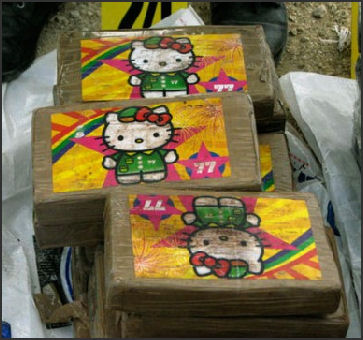
Hello Kitty cocaine The rights to Hello Kitty are own by the Sanrio Company. The stuff is made by a variety of companies that have purchased the licensing rights from Sanrio. The licensing rights aren't all that expensive, which means most Hello Kitty products are not expensive. Volume has been the key to success and profits.
Among the 50,000 Hello Kitty products on the market are glasses, hairpins, lockets, bras, alarm clocks, sanitary napkins, eyelash curlers, baby biscuits, toilet paper, fishcakes, frozen jelly, prunes, bicycles, perfume, fax machines, garbage cans, panties, spatulas, motorcycles, cell phone cases, tea towels, dolls and toasters that spit out Hello Kitty imprinted toast.
Companies that license Hello Kitty are allowed to do pretty much whatever they want with the image. Each years 12,000 new products are put on the market. It is possible to eat in a Hello Kitty kitchen in which every appliance has a Hello Kitty logo or work at a desk in which your computer, mouse, pencils and paper clips have the character in it. When you hit the beach you can do it in style with a Hello Kitty bikini and matching surfboard and wetsuit.
Hello Kitty products are sold everywhere: supermarkets, ¥100 stores, pharmacies, department stores, street stalls, duty-free shops, and shops that specialize in Hello Kitty stuff. The Hello Kitty theme park, Puroland, outside of Tokyo, attracts 1.3 million visitors a year.
In 2006, Hello Kitty beginner versions of the Fender Stratocasters went on sale for $300. Other items aimed for adults includes Hello Kitty lingerie, champagne flites, license plate frames, steering wheel covers and negative ion air purifiers. For information on the latest stuff you can always check Kitty Goods Collection magazine.
Hello Kitty isn't found on everything. Sanrio refused to license the image for "negative" products such as cigarettes, liquor, knives, guns or pornography. You however can get Hello Kitty beer and a Hello Kitty vibrators.
Hello Kitty Fans
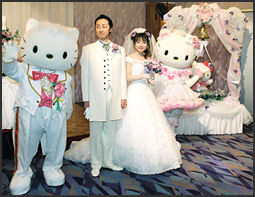
Hello Kitty wedding In 2000, there was a riot at a Singapore McDonalds that ran out Hello Kitty dolls. There are reports that Bill Gates once offered $5.6 billion for the rights to Kitty.
Hello Kitty’s success has been attributed to “social communication,” kawaii (cute) culture, ans higher disposable incomes. It is hard to explain Kitty’s staying power and ability to defy brand fatigue. One Hello Kitty fan wrote on a Internet message board, “I just like her because she is like the Mona Lisa, you never know of she is smiling or she is sad.”
But that is not to say that Hello Kitty has not produced some brand fatigue. One 25-year-old Tokyoite told Reuters, “From cutlery and coffee cups to the toilet seat covers, almost everything in my one-room apartment was Hello Kitty, even the curtains...But after a while, on TV and in magazines it was just Kitty Kitty Kitty...I couldn’t keep up anymore.”
On the appeal of Hello Kitty, American artist Bill Griffith told the Daily Yomiuri she is “a blank slate...Having no mouth undoubtably helped. HK [Hello Kitty] is in that thin borderline between cuteness and creepiness, where much kitsch resides. Her bland appearance acts as a mask to the unknown persona inside. She has a trickster quality: is she fun-loving and innocent, or evil and subversive? HK is a deep mystery like all religious icons.” Leaving out the mouth, which is often used to convey feelings and expressions, leave it up to viewers to use their imaginations to project their own feeling onto her.
Hello Kitty Abroad
In August 2010, Hello Kitty rang the closing bell at the New York Stock Exchange to mark Sanrio’s 50th anniversary.
"Hello Kitty" is very big in China. She has been named as the ambassador of Japanese tourism in Chinese mainland and Hong Kong, where she enjoys huge popularity among children and young ladies. Hello Kitty's parent company, Sanrio, has agreed to work with a Shanghai-based developer to help attract Chinese fans.
In May 2011 it was announced that a Hello Kitty Theme Park will be built in Anji, Zhejiang Province and this will be her first home outside Japan since she was created 37 years ago. Visitors to the amusement park will be able to enjoy 3D Games, animated Hello Kitty films and onsite food service. Construction is expected to begin in July, and is projected to open in 2014. [Source: CCTV, May 10, 2011]
In November 2010, a Dutch court ordered Sanrio to stop production of goods with Cathy Rabbit because the character it imitated the famous Dutch rabbit Miffy. In a settlement agreed upon by Miffy’s creator Dick Bruna Sanrio agreed to stop making Cathy Rabbit products and both Banrio and promised to respect each other’s copyrights and each donate 150,000 euros to relief for the March 2011 earthquake and tsunami.
In December 2011 Sanrio, the owner of Hello Kitty, acquired the “Mr Men” franchise from Chorion of Britain. The deal, for an estimated ¥3 billion ($40m), brings the Japanese design and licensing firm 86 playful characters, including Mr. Bump and Mr. Tickle, who have delighted toddlers in 30 countries and shifted 100 million books. The purchase of Mr. Men was part of Sanrio’s effort to become a global merchandizing force. The decision was made by Sanrio CEO Ray Hatoyama, who grew up in Australia watching Mr. Men. [Source: The Economist, December 17, 2011]
Image Sources: Ray Kinnane; xorsyst blog; 3) Japan Visitors
Text Sources: New York Times, Washington Post, Los Angeles Times, Daily Yomiuri, Times of London, Japan National Tourist Organization (JNTO), National Geographic, The New Yorker, Time, Newsweek, Reuters, AP, Lonely Planet Guides, Compton’s Encyclopedia and various books and other publications.
Last updated January 2013
